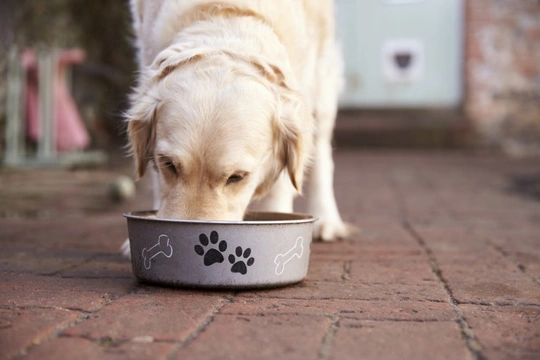
What does it mean if your dog moves their food away from their bowl to eat?
Most dog owners find themselves flummoxed at some point when faced with the sometimes strange behaviours that dogs exhibit – and even though dogs and humans have lived side by side for millennia and evolved together over this time, we as people still sometimes find it hard to translate the meanings of all of the things our dogs do.
However, just because we can’t work out why the dog is doing a certain thing doesn’t mean that there is not an impeccable level of logic going on in the mind of your dog – and learning how dogs think and what motivates them to act in certain ways can help us to interpret the causes of all manner of strange behaviours.
Dogs often have a lot of complex rituals and behaviours relating to food in particular, which makes sense because food is very important to dogs, and one of their most powerful motivators. Whilst this generally manifests as a seemingly obsessive level of interest in food of all types and how to get it, some of our dogs’ food-related behaviours can still seem quite odd – such as if your dog moves their food away from their bowl to eat it elsewhere, or deliberately moves the whole bowl and its contents somewhere else before relaxing to eat.
If this sounds like your dog, there might be something about where, when and how your dog is fed that they’re not totally happy with – or they may be trying to save and guard their most valued resources.
In this article, we will examine what it means if your dog moves their food away from their bowl to eat, or moves their whole bowl, and why they might be doing this. Read on to learn more.
Resource guarding
Dogs value having their own territory, and their own toys, beds, and resources too, but few things are as valuable to the average dog as food. If your dog moves their food around or takes their food away before eating it, they might simply be trying to keep it to themselves and make sure nobody else uses the bowl or shares (or steals) their meal.
This is a behaviour that develops in some dogs from the time that they are puppies, when they are in competition with the rest of their litter for food. Because small puppies that are starting to eat solid food for the first time are usually fed together and not given separate bowls, the pups will often try to get as much food as they can when the food appears, and then retreat to a quiet corner with it to enjoy it in peace.
Too much noise and movement
Nobody likes to be bothered or disturbed when eating, and the same applies to your dog as well. If your dog is fed in a busy area of the home where a lot of people pass them by, or in the kitchen when you are preparing food for the family and there are a lot of people around, your dog might simply want to eat somewhere quieter.
If your dog feels as if they have to keep an eye on what’s happening around them, is diverted by external stimulus or worries about people getting too close to them when they are eating, they might decide to make dinner a takeaway and eat it in the spot of their choice.
Hoarding for later
In the wild, dogs bury food that they can’t manage to eat all in one go, to save it for later when resources are leaner and might be in shorter supply. Some domestic dogs still manifest this behaviour by taking food from their bowl and trying to hide it in their bed or crate, either because they couldn’t eat it all at once and want to save it, or as a safeguard against future hunger – even if your dog has never had cause to fear where their next meal is coming from!
They don’t like their bowl
If your dog’s bowl is rattly, or slides around on the floor, it may be frustrating or irritating for your dog when they try to eat from it. If they aren’t keen on their bowl for whatever reason, they might take their food from it and eat it somewhere more pleasant.
Another dog intimidates them when they eat
Finally, if you keep two or more dogs together, feeding times can be fairly stressful if the dogs are fed together, as there is usually a dominant dog that will expect to eat first, and get the best meal.
Such dogs may also try to push the other dog away from their food and steal their meal, or otherwise be intimidating and discourage the other dog from enjoying their food, even if you supervise the dogs to make sure they all stick to their own bowls.
If this is an issue with your own dogs, try feeding them in separate rooms, or staggering meal times so that each dog has the chance to eat alone and in peace, without feeling the need to hide their meal.



